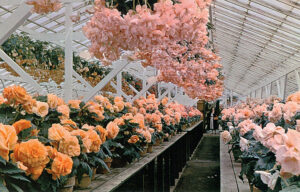By Deborah Osterberg
By the 1950s, Capitola was known as the “Begonia Capital of the World.” This led to the beloved Begonia Festival, which ran from the early 1950s until 2017. Capitola as a center of flower growing went back to the early 1900s. Capitola’s climate was perfect for growing because “the high fog gave strong light without direct sun and the fog kept a certain moistness in the air.”

Vetterle & Reinelt Begonia Gardens, once located at Capitola Road and 45th Avenue. • Courtesy of Capitola Historical Museum
John V. Vetterle who arrived from Merced in 1910, purchased 16 acres in Capitola Heights where he intended to raise chickens and strawberries. By 1912, he began a flower nursery where he grew begonias, iris, gladiolas, and freesias. When he passed away in 1917, his sons Lowell and Everett took over the business.
Vetterle Brothers’ greenhouses and lath houses were located on 45th Avenue. The brothers’ business interests included a butane gas business, the famed Capitola Beach Club and Ballroom, and rental properties in San Francisco. Everett was very active in the community as a member of the Soquel Chamber of Commerce, the farm bureau, and the county fair board of directors.
In 1934, the Vetterle brothers allowed a young Czechoslovakian gardener, working on a Los Altos estate, plant an acre of their land for an experiment to produce seeds of the double-flowered begonia. When the experiment proved successful, the brothers brought the skilled hybidizer, Frank Reinelt, onboard as partner.
A 1938 advertisement declared that at Vetterle & Reinelt… their greenhouses are crowded with a colorful display of specimens that defy description. In addition they have developed prized strains of delphinium, gloxinias and daffodils. The greenhouses, hot houses and open gardens are ablaze with the many colors of their creations. Seeds from this establishment go to all parts of the world, and scientists and experts have come from everywhere to pay honor to these local men who have contributed so much to their profession.
Much of this success was due to the skill of Frank Reinelt. Reportedly only 14 years old when he attended a university in Bohemia, by the age of 22, he became the head gardener for the Queen of Romania. In 1925 he made his way to California, lured there by its mild climate and in hopes of meeting one of his heroes, the horticulturist Luther Burbank. Unfortunately, Burbank passed away before the two could meet.
Reinelt was responsible for developing many improved forms of tuberous begonias, from the Classical Rose, the Ruffled Camelia Type, to the Picotee Shades. He also developed the Pacific strain of delphinium. Reinelt received medals for his plant breeding from the State of California, the California Horticultural Society, the American Begonia Society, and the American Delphinium Society.
Vetterle & Reinelt faced fierce competition in the begonia field with neighboring Capitola nurseries, Antonelli Brothers, and the Brown Bulb Ranch. The high quality of Vetterle & Reinelt stock was gaining steady recognition. According to the June 27, 1939, Santa Cruz Sentinel, “One of the outstanding features of the floriculture exhibit at the Golden Gate International Exposition is a contribution from Santa Cruz County. Vetterle & Reinelt, of Capitola have demonstrated the superiority of their tuberous begonias and gloxinias in a convincing way. Theirs is the most colorful exhibit in the building. You need only to see their specimens as the fair to be convinced that this firm is doing a noble job of advertising the beauty of Santa Cruz County.”
In 1943, Everett Vetterle was killed in an automobile accident in San Francisco. Frank Reinelt said of Everett that “[h]e was the kindest, the finest partner a man could have.”
Despite the huge loss of one of its founders, Vetterle & Reinelt continued to dominate the begonia business. Perhaps owing to Reinelt’s past, the nursery was a favorite with European royalty. The Duke and Duchess of Windsor were regular customers, even telephoning the Capitola nursery to check on the delivery date of shipments for their Paris home.
Visitors were welcome to tour their Capitola hybridizing gardens in August and September, when over a million tuberous begonias bloomed.
By the early 1960s, in addition to the Capitola facility, Vetterle & Reinelt maintained fields of begonias on Mission Street in Santa Cruz and at La Selva Beach.
In 1969 Frank Reinelt left the partnership and moved to Nevada to experiment with cacti and succulents. Lowell Vetterle sold out to another nursery in 1972. Capitola as a center of begonia growing continued until 2017, when the last source of Capitola begonias, Golden State Bulb Growers, ceased operations.
This Labor Day weekend (Sept. 3 &4) the public is invited to Begonia Festival Tribute activities at Capitola City Hall and Esplanade Park hosted by the Capitola Arts & Cultural Commission, the Capitola Historical Museum, and the Capitola Beach Festival.